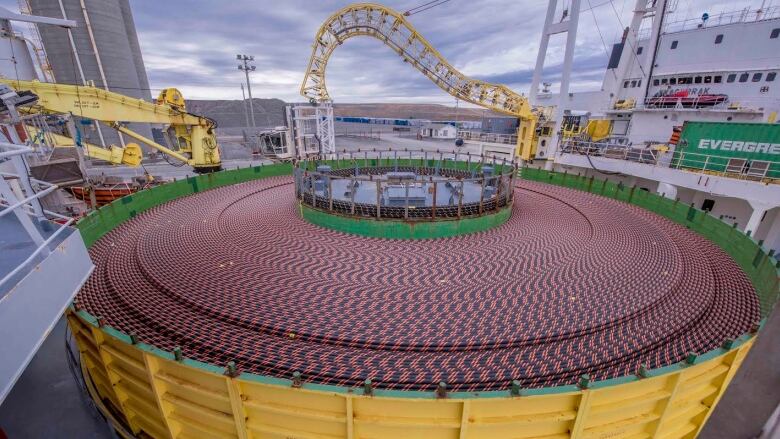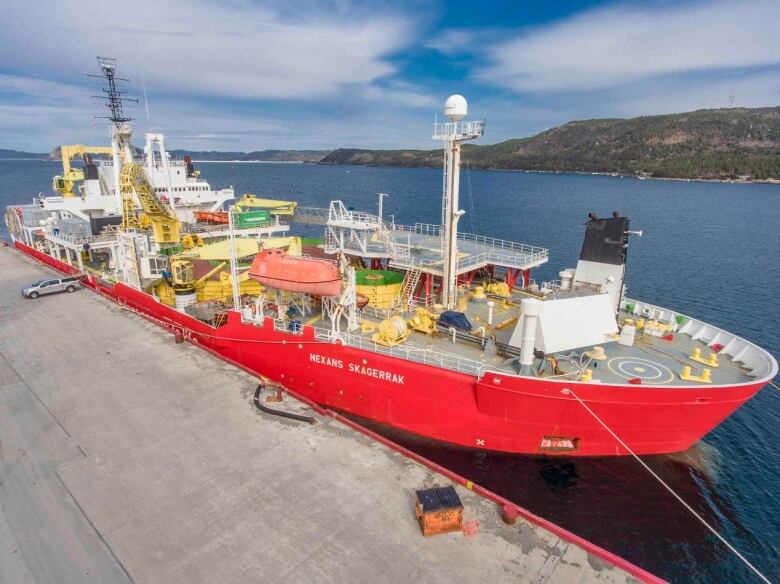How do you lay a 170-km cable on the bottom of the sea? Slowly and carefully
Installation of Maritime Link subsea cable between Newfoundland and Nova Scotia has begun

The giant spools and the two sections of Maritime Link subsea cable wrapped around them have the combined weight of5,500 tonnes heavier than the Eiffel Tower.
On Wednesday night, workers began installing one of the170-kilometrecables, whichwill eventually run betweenCape Ray, N.L., and Point Aconi, N.S.
"It's one big piece of cable," said Rick Janega, the president and chief executive ofEmeraNewfoundland & Labrador, the parent company of NSP Maritime Link, whichowns the project.
The first end of the cable to be laidwas threaded through a one-kilometre borehole, pulled through some casing and onto the Newfoundland shore. The second cable, which will be laid separately, is still in transitand is expected toarrive in Atlantic Canada from Japan, where it was manufactured, in mid-May.
The cable itself is about 10 centimetres thick, or about the diameterof a two-litre plastic pop bottle.
The $1.7-billionMaritime Link will bring electricity harnessed from the Muskrat Falls hydroelectric project inLabrador to Nova Scotia.
Nalcor Energy'sMuskrat Fallsproject is over budget and two years behind schedule. But NSP Maritime Link said earlier this year it was nonetheless forging ahead with itssubsea cable because delaying it could cost the company up to $500 million.
Lowering the cable
So, how does oneget this monster of a cable which will be the longest submarine electricity cable in North America when it's donesafely to the bottom of the sea?
Slowly. At a pace of about one kilometre per hour, to be precise.

A ship called Skagerrak, a vessel that's specifically designed to lay cables, will motor along at that speed as the cable is slowly uncoiled over the back of the vessel.
"The turntable that the cable sits onrotates and there aretensionerson the vessel that control the speed and the pace at which the cable is laid out," Janega said.
When it reaches the deepest part of the Cabot Strait, a depth of about470 metres,it will be monitored remotely.
"There are remote-operated vehicles that have cameras and sensors on it that will watch the touchdown to ensure it's placed in a safe location," said Janega.
Parts will be buried
The line from Newfoundland to Nova Scotia will not becompletely straight, as the installation must avoidholes in the sea floor and goaround large rocks or outcrops.
In shallow water, the cable will beburied to protect it from fishing gear, anchors or ice.
Once the cable is laid on the sea floor, another vessel called a Capjet, which looks like an underwaterdunebuggy, will comealong behindthe ship. It will usehigh-pressure water jets to push softer material out of the way andcreatea trench into which the cable will fall.
Indeeper water, the cable doesn't need to be buried.
"Once you get over a couple of hundred metres of water depth, the currents are very low, so the movement of the sea floor or the cable is minimal," Janega said.
Within about two weeks, the cable is expected to be pulled ashore at the Point Aconi site north of the power plant.
With files from CBC's Information Morning












_(720p).jpg)


 OFFICIAL HD MUSIC VIDEO.jpg)
.jpg)



























































































